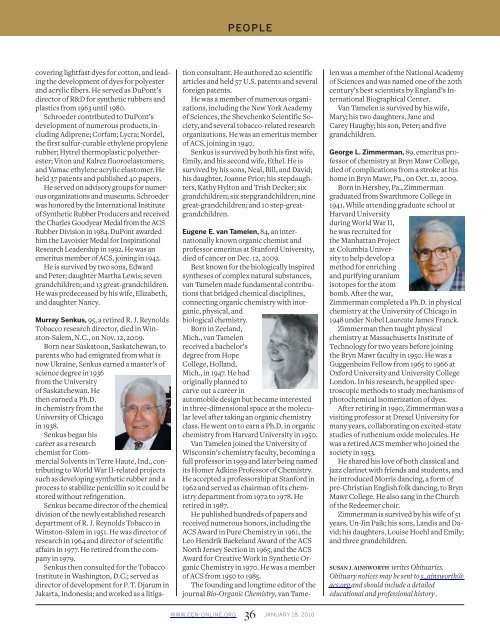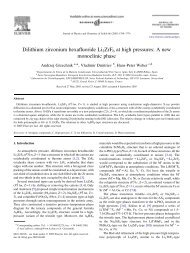Chemical & Engineering News Digital Edition - January 18, 2010
Chemical & Engineering News Digital Edition - January 18, 2010
Chemical & Engineering News Digital Edition - January 18, 2010
Create successful ePaper yourself
Turn your PDF publications into a flip-book with our unique Google optimized e-Paper software.
covering lightfast dyes for cotton, and leading<br />
the development of dyes for polyester<br />
and acrylic fibers. He served as DuPont’s<br />
director of R&D for synthetic rubbers and<br />
plastics from 1963 until 1980.<br />
Schroeder contributed to DuPont’s<br />
development of numerous products, including<br />
Adiprene; Corfam; Lycra; Nordel,<br />
the first sulfur-curable ethylene propylene<br />
rubber; Hytrel thermoplastic polyetherester;<br />
Viton and Kalrez fluoroelastomers;<br />
and Vamac ethylene acrylic elastomer. He<br />
held 37 patents and published 40 papers.<br />
He served on advisory groups for numerous<br />
organizations and museums. Schroeder<br />
was honored by the International Institute<br />
of Synthetic Rubber Producers and received<br />
the Charles Goodyear Medal from the ACS<br />
Rubber Division in 1984. DuPont awarded<br />
him the Lavoisier Medal for Inspirational<br />
Research Leadership in 1992. He was an<br />
emeritus member of ACS, joining in 1942.<br />
He is survived by two sons, Edward<br />
and Peter; daughter Martha Lewis; seven<br />
grandchildren; and 13 great-grandchildren.<br />
He was predeceased by his wife, Elizabeth,<br />
and daughter Nancy.<br />
Murray Senkus, 95, a retired R. J. Reynolds<br />
Tobacco research director, died in Winston-Salem,<br />
N.C., on Nov. 12, 2009.<br />
Born near Saskatoon, Saskatchewan, to<br />
parents who had emigrated from what is<br />
now Ukraine, Senkus earned a master’s of<br />
science degree in 1936<br />
from the University<br />
of Saskatchewan. He<br />
then earned a Ph.D.<br />
in chemistry from the<br />
University of Chicago<br />
in 1938.<br />
Senkus began his<br />
career as a research<br />
chemist for Commercial<br />
Solvents in Terre Haute, Ind., contributing<br />
to World War II-related projects<br />
such as developing synthetic rubber and a<br />
process to stabilize penicillin so it could be<br />
stored without refrigeration.<br />
Senkus became director of the chemical<br />
division of the newly established research<br />
department of R. J. Reynolds Tobacco in<br />
Winston-Salem in 1951. He was director of<br />
research in 1964 and director of scientific<br />
affairs in 1977. He retired from the company<br />
in 1979.<br />
Senkus then consulted for the Tobacco<br />
Institute in Washington, D.C.; served as<br />
director of development for P. T. Djarum in<br />
Jakarta, Indonesia; and worked as a litiga-<br />
PEOPLE<br />
tion consultant. He authored 20 scientific<br />
articles and held 57 U.S. patents and several<br />
foreign patents.<br />
He was a member of numerous organizations,<br />
including the New York Academy<br />
of Sciences, the Shevchenko Scientific Society,<br />
and several tobacco-related research<br />
organizations. He was an emeritus member<br />
of ACS, joining in 1940.<br />
Senkus is survived by both his first wife,<br />
Emily, and his second wife, Ethel. He is<br />
survived by his sons, Neal, Bill, and David;<br />
his daughter, Joanne Prior; his stepdaughters,<br />
Kathy Hylton and Trish Decker; six<br />
grandchildren; six stepgrandchildren; nine<br />
great-grandchildren; and 10 step-greatgrandchildren.<br />
Eugene E. van Tamelen, 84, an internationally<br />
known organic chemist and<br />
professor emeritus at Stanford University,<br />
died of cancer on Dec. 12, 2009.<br />
Best known for the biologically inspired<br />
syntheses of complex natural substances,<br />
van Tamelen made fundamental contributions<br />
that bridged chemical disciplines,<br />
connecting organic chemistry with inorganic,<br />
physical, and<br />
biological chemistry.<br />
Born in Zeeland,<br />
Mich., van Tamelen<br />
received a bachelor’s<br />
degree from Hope<br />
College, Holland,<br />
Mich., in 1947. He had<br />
originally planned to<br />
carve out a career in<br />
automobile design but became interested<br />
in three-dimensional space at the molecular<br />
level after taking an organic chemistry<br />
class. He went on to earn a Ph.D. in organic<br />
chemistry from Harvard University in 1950.<br />
Van Tamelen joined the University of<br />
Wisconsin’s chemistry faculty, becoming a<br />
full professor in 1959 and later being named<br />
its Homer Adkins Professor of Chemistry.<br />
He accepted a professorship at Stanford in<br />
1962 and served as chairman of its chemistry<br />
department from 1972 to 1978. He<br />
retired in 1987.<br />
He published hundreds of papers and<br />
received numerous honors, including the<br />
ACS Award in Pure Chemistry in 1961, the<br />
Leo Hendrik Baekeland Award of the ACS<br />
North Jersey Section in 1965, and the ACS<br />
Award for Creative Work in Synthetic Organic<br />
Chemistry in 1970. He was a member<br />
of ACS from 1950 to 1985.<br />
The founding and longtime editor of the<br />
journal Bio-Organic Chemistry, van Tame-<br />
WWW.CEN-ONLINE.ORG 36 JANUARY <strong>18</strong>, <strong>2010</strong><br />
len was a member of the National Academy<br />
of Sciences and was named one of the 20th<br />
century’s best scientists by England’s International<br />
Biographical Center.<br />
Van Tamelen is survived by his wife,<br />
Mary; his two daughters, Jane and<br />
Carey Haughy; his son, Peter; and five<br />
grandchildren.<br />
George L. Zimmerman, 89, emeritus professor<br />
of chemistry at Bryn Mawr College,<br />
died of complications from a stroke at his<br />
home in Bryn Mawr, Pa., on Oct. 21, 2009.<br />
Born in Hershey, Pa., Zimmerman<br />
graduated from Swarthmore College in<br />
1941. While attending graduate school at<br />
Harvard University<br />
during World War II,<br />
he was recruited for<br />
the Manhattan Project<br />
at Columbia University<br />
to help develop a<br />
method for enriching<br />
and purifying uranium<br />
isotopes for the atom<br />
bomb. After the war,<br />
Zimmerman completed a Ph.D. in physical<br />
chemistry at the University of Chicago in<br />
1948 under Nobel Laureate James Franck.<br />
Zimmerman then taught physical<br />
chemistry at Massachusetts Institute of<br />
Technology for two years before joining<br />
the Bryn Mawr faculty in 1950. He was a<br />
Guggenheim Fellow from 1965 to 1966 at<br />
Oxford University and University College<br />
London. In his research, he applied spectroscopic<br />
methods to study mechanisms of<br />
photochemical isomerization of dyes.<br />
After retiring in 1990, Zimmerman was a<br />
visiting professor at Drexel University for<br />
many years, collaborating on excited-state<br />
studies of ruthenium oxide molecules. He<br />
was a retired ACS member who joined the<br />
society in 1953.<br />
He shared his love of both classical and<br />
jazz clarinet with friends and students, and<br />
he introduced Morris dancing, a form of<br />
pre-Christian English folk dancing, to Bryn<br />
Mawr College. He also sang in the Church<br />
of the Redeemer choir.<br />
Zimmerman is survived by his wife of 51<br />
years, Un-Jin Paik; his sons, Landis and David;<br />
his daughters, Louise Hoehl and Emily;<br />
and three grandchildren.<br />
SUSAN J. AINSWORTH writes Obituaries.<br />
Obituary notices may be sent to s_ainsworth@<br />
acs.org and should include a detailed<br />
educational and professional history .




